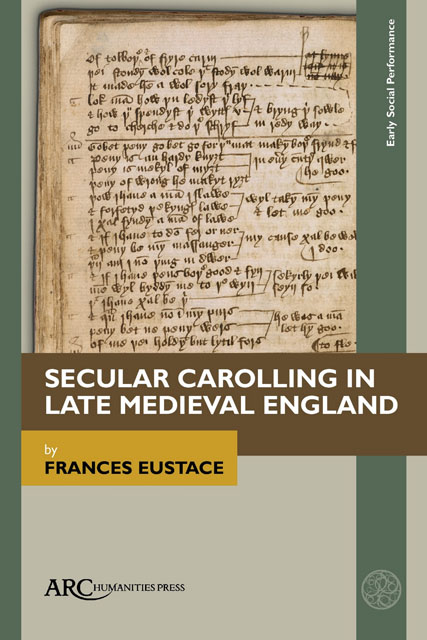Book contents
- Frontmatter
- Contents
- List of Illustrations
- Preface
- Introduction
- Chapter 1 Carolling and Dance-Song in the Context of a Primarily Oral Culture
- Chapter 2 Courtly Carolling: Contexts and Practices
- Chapter 3 The Church, Carolling, and the Emergence of the English Franciscan Carole Writers of The Fourteenth and Fifteenth Centuries
- Chapter 4 Carole Texts in Context: The Manuscripts
- Chapter 5 Carole Texts as Witnesses to Carolling Practice
- Chapter 6 Survivances Of Carolling In Folk Culture
- Conclusion: Carolling from a Dance Movement Psychotherapy Perspective
- Bibliography
- Index
Chapter 2 - Courtly Carolling: Contexts and Practices
Published online by Cambridge University Press: 06 April 2023
- Frontmatter
- Contents
- List of Illustrations
- Preface
- Introduction
- Chapter 1 Carolling and Dance-Song in the Context of a Primarily Oral Culture
- Chapter 2 Courtly Carolling: Contexts and Practices
- Chapter 3 The Church, Carolling, and the Emergence of the English Franciscan Carole Writers of The Fourteenth and Fifteenth Centuries
- Chapter 4 Carole Texts in Context: The Manuscripts
- Chapter 5 Carole Texts as Witnesses to Carolling Practice
- Chapter 6 Survivances Of Carolling In Folk Culture
- Conclusion: Carolling from a Dance Movement Psychotherapy Perspective
- Bibliography
- Index
Summary
SCENES OF CAROLLING and references to the activity in courtly culture can be found in much of the literature of the late Middle Ages. The dependence of carolling upon the use of burdens or refrains, as already defined in the Introduction above, and the practice of including refrain material in literary works of the roman à chansons has also resulted in a large corpus of research in the field of refrain studies. Some of these studies have included the carole. However, because the focus of these scholars has also been predominantly on the romance literary sources, there has been an inevitable association of carolling with the idealized fictional world of courtly love and chivalry. Here we re-examine the record of courtly carolling in the context of a universal, though un-notated, medieval dance culture, for information about two main aspects of the practice. Firstly, when and why did carolling take place and secondly, how was it executed? We will review literary examples alongside accounts of carolling in chronicles and other pseudo-historical records to demonstrate that references to courtly carolling, as an activity, were not confined to romance narrative. As is well known, Francophile tastes continued to influence English court culture for the greater part of the four centuries after the Conquest in 1066, despite periods of enmity between the two countries. Hence there is a “striking absence” of English courtly love lyrics until the fifteenth century, and this lacuna in the written record applies equally to carole texts. The shared nature of the culture, therefore, leads us to French literary sources for information on insular courtly practices, including carolling.
The narratives of romans à chansons offer the most detailed descriptions of dance-song scenes. Although the songs are not always defined as caroles it is clear from the context that they represent the activity of carolling if, for example, the preceding narrative has introduced the idea with a phrase such as Ainz i sont si granz karoles. Jean Renart claimed that he was the first writer to include songs within a narrative, in Le Roman de la Rose ou Guillaume de Dole (ca. 1228), although other writers in the early thirteenth century, including Gautier de Coincy, were also exploring the genre that became known as roman à chanson.
- Type
- Chapter
- Information
- Secular Carolling in Late Medieval England , pp. 15 - 34Publisher: Amsterdam University PressPrint publication year: 2022

